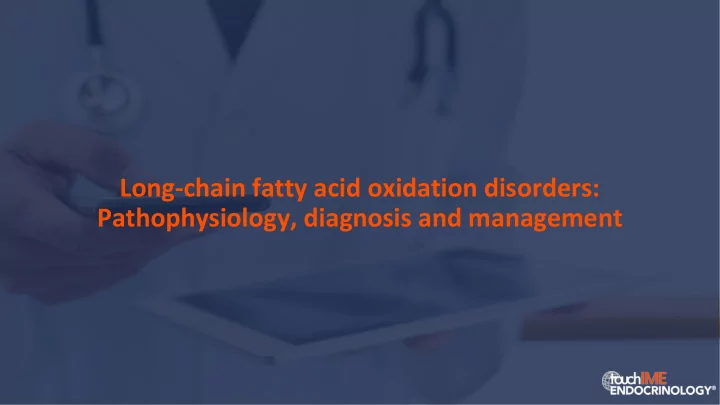

Long-chain fatty acid oxidation disorders: Pathophysiology, diagnosis and management
How are LC-FAOD currently managed and how may this change in the future? Dr Jerry Vockley Director, Center for Rare Disease Therapy and Chief of Medical Genetics, Children's Hospital of Pittsburgh of UPMC, Pittsburgh, PA, USA LC-FAOD, long-chain fatty acid oxidation disorders.
Disclaimer Unapproved products or unapproved uses of approved products may be discussed by the faculty; these situations may reflect the approval status in one or more jurisdictions. The presenting faculty have been advised by touchIME to ensure that they disclose any such references made to unlabelled or unapproved use. No endorsement by touchIME of any unapproved products or unapproved uses is either made or implied by mention of these products or uses in touchIME activities. touchIME accepts no responsibility for errors or omissions.
Nutritional management for FAOD 1–3 Avoid fasting Restrict LCTs and provide alternative • 4 hours maximum fast until age 4 months, energy sources with 1 additional hour/month up to 8 hours • Provide adequate nutrition for growth maximum until age 1 year and development • Up to 10-hour overnight fast after infancy • Supplement with MCT to replace LCT (extent dependent on severity of FAOD) • Protein supplementation FAOD, fatty acid oxidation disorders; LCT, long-chain triglycerides; MCT, medium-chain triglycerides; OCTN 2, organic cation transporter 2. 1. Merritt JL II, et al. Ann Transl Med. 2018;6:473. 2. Knottnerus SJG, et al. Rev Endocr Metab Disord. 2018;19:93–106. 3. Spiekerkoetter U, et al. J Inherit Metab Dis . 2009;32:498–505.
Nutritional management for FAOD 1–3 Increased caloric need during illness Carnitine supplementation • Carbohydrate-rich enteral fluids • Low-dose supplementation may ameliorate • IV dextrose if necessary myopathic symptoms • Controversial due to theoretical risk of cardiac arrhythmias FAOD, fatty acid oxidation disorders; IV, intravenous. 1. Merritt JL II, et al. Ann Transl Med. 2018;6:473. 2. Knottnerus SJG, et al. Rev Endocr Metab Disord. 2018;19:93–106. 3. El-Gharbawy A and Vockley J. Pediatr Clin North Am . 2018;65:317–35.
Unmet needs and patient risks despite nutritional therapy 1,2 Older patients Patients at any age Recurrent rhabdomyolysis leads to accumulation of blood CPK and myoglobin, causing kidney Muscle symptoms, myopathy damage/failure and rhabdomyolysis Younger patients Loss of consciousness Increased and coma blood Low Acute or chronic ammonia blood cardiomyopathy Liver damage sugar (usually reversible) CPK, creatinine phosphokinase. 1. Knottnerus SJG, et al. Rev Endocr Metab Disord. 2018;19:93–106. 2. Moniz MS, et al. Rev Bras Ter Intensiva . 2017;29:111–4.
Future approaches: Triheptanoin 78-week single-arm Phase II study in 29 patients with Highly purified, synthetic medium odd-chain severe LC-FAOD (mean age 12 years) 1,2 (C7) triglyceride, which is catabolized to • Triheptanoin titrated to 25–35% of calorie intake heptanoate and crosses the mitochondrial Significant reduction in rate of major clinical membrane without carnitine, bypassing events and hospitalizations at 78 weeks faulty LC metabolic mechanisms 1 compared with 78 weeks before study • Majority of subjects on MCT in the Metabolized by medium-chain pre-study period fatty acid oxidation enzymes Metabolic products contribute to energy Improved exercise Significant improvements in metabolism and glycogen sparing endurance and physical health composite scores tolerance at interim of SF-12v2 after 24 weeks, analysis and week 60 maintained to 78 weeks LC, long-chain; LC-FAOD, long-chain fatty acid oxidation disorders; MCT, medium-chain triglycerides; SF-12v2, Medical Outcomes Study Short Form version 2. 1. Vockley J, et al. Molec Genet Metab. 2017:120:370–7. 2. Vockley J, et al. J Inherit Metab Dis . 2019;42:169–77.
Future approaches: PPAR δ agonists 1 Liver Increases fatty PPAR Skeletal and acid metabolism Upregulation of δ cardiac muscle energy metabolism genes in all tissues Adipose tissue Reduces inflammation and improves muscle symptoms Macrophages Phase 1 safety study with REN001 is underway in patients with fatty acid oxidation disorders 2 PPAR, peroxisome proliferator–activated receptor. 1. Reilly SM, Lee C-H. FEBS Lett. 2008;582:26–31. 2. Clinicaltrials.gov. February 2019. [Cited 27 February 2020]. Available from: https://clinicaltrials.gov/ct2/show/NCT03833128.
Recommend
More recommend